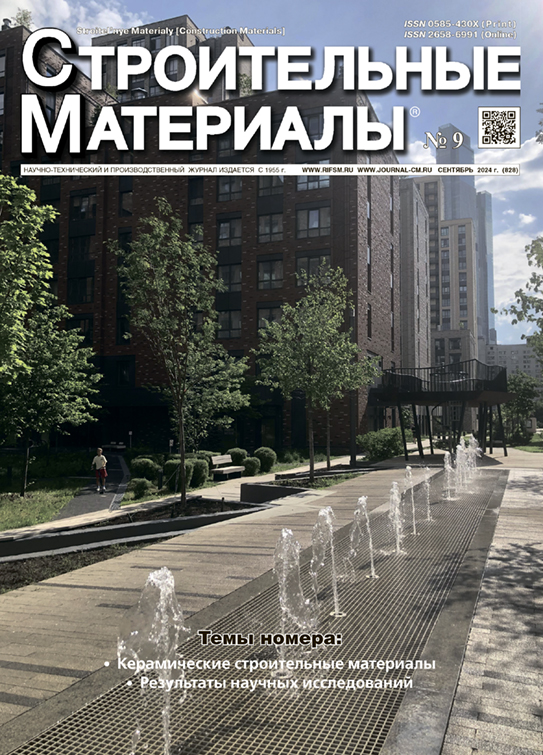Ceramic materials of low-temperature sintering from natural and technogenic rocks of the Tuva Republic
- Autores: Storozhenko G.I.1, Sapelkina T.V.2, Shoeva Т.Е.1, Sebelev I.M.1
-
Afiliações:
- Novosibirsk State University of Architecture and Civil Engineering (Sibstrin)
- Tuva Institute of Integrated Development of Natural Resources, Siberian Branch of the Russian Academy of Sciences
- Edição: Nº 9 (2024)
- Páginas: 11-15
- Seção: Статьи
- URL: https://archivog.com/0585-430X/article/view/636781
- DOI: https://doi.org/10.31659/0585-430X-2024-828-9-11-15
- ID: 636781
Citar
Texto integral
Resumo
Abroad, they are actively engaged in “cold” sintering of materials, including ceramic, which is a mechanically and thermally conditioned mass transfer process that allows for low-temperature integration of various materials. The paper presents the results of research on low-temperature sintering and optimization of firing regimes for ceramic materials by introducing a salt complex with a liquidus temperature of 825оC into a charge based on natural and man-made rocks of the Republic of Tyva. The optimal concentrations of salt-containing additives in the ceramic mass, which affect the roasting properties of the resulting materials, have been determined. It was found that the introduction of a complex of salts into the ceramic charge promotes earlier sintering of the shard and the production of high-quality wall ceramics at lower temperatures, which leads to a reduction in energy costs during firing of products.
Texto integral
Sobre autores
G. Storozhenko
Novosibirsk State University of Architecture and Civil Engineering (Sibstrin)
Autor responsável pela correspondência
Email: baskey_ltd@mail.ru
Doctor of Sciences (Engineering) Docent
Rússia, 113, Leningradskaya Street, Novosibirsk, 630008T. Sapelkina
Tuva Institute of Integrated Development of Natural Resources, Siberian Branch of the Russian Academy of Sciences
Email: sapelkina_geotom@mail.ru
Research Assistant
Rússia, 117A, Internatsionalnaya Street, Kyzyl, Tyva Republic, 667007Т. Shoeva
Novosibirsk State University of Architecture and Civil Engineering (Sibstrin)
Email: shoeva_geotom@mail.ru
Candidate of Sciences (Engineering)
Rússia, 113, Leningradskaya Street, Novosibirsk, 630008I. Sebelev
Novosibirsk State University of Architecture and Civil Engineering (Sibstrin)
Email: i.sebelev@sibstrin.ru
Doctor of Sciences (Engineering), Docent
Rússia, 113, Leningradskaya Street, Novosibirsk, 630008Bibliografia
- On the approval of the Information and Technical Handbook on the best available technologies «Production of ceramic products.» ITS 4-2023. Moscow: GTC. 2023. 368 p. (In Russian).
- Shishakina O.A., Palamarchuk A.A. Application of fluxes in the production of ceramic materials. Mezhdunarodnyy zhurnal prikladnykh i fundamental’nykh issledovaniy. 2019. No. 11, pp. 105–109. (In Russian).
- Gurieva V.A., Dubinetskiy V.V., Vdovin K.M., Butrimova N.V. Wall ceramic on the basis of highly calcined raw materials of Orenburzhye. Stroitel’nye materialy [Construction Materials]. 2016. No. 12, pp. 55–58. (In Russian).
- Yatsenko N.D., Vilbitskaya N.A., Yatsenko A.I. Features of the formation of the phase composition and properties of high-calcium low-density ceramics based on clay raw materials of various chemical and mineralogical composition. Izvestiya of higher educational institutions. North Caucasian region. Series: Technical sciences. 2021. No. 2 (210), pp. 75–80. (In Russian). https://doi.org/10.17213/1560-3644-2021-2-75-80
- Dovzhenko I.G. Intensification of agglomeration of ceramic brick with application of the waste of aluminium manufacture. Fundamental’nye issledovaniya. 2011. No. 12 (2), pp. 341–344. (In Russian). https://fundamental-research.ru/ru/article/view?id=29085
- Storozhenko G.I. Technology for the production of wall ceramic products from activated clay raw materials. Diss. Doc. (Engineering). Tomsk. 2000. 231 p. (In Russian).
- Kara-Sal B.K. Ceramic building materials obtained by firing at reduced pressure (technology, structure and properties). Diss. Doc. (Engineering). Novosibirsk. 2007. 307 p. (In Russian).
- Kurnosov V.V., Tihonova V.R. Hood furnace – universal unit for burning ceramics. Stroitel’nye Materialy [Construction Materials]. 2023. No. 5, pp. 48–52. (In Russian). https://doi.org/10.31659/0585-430X-2023-813-5-48-52
- Biesuz M., Saunders T.G., Grasso S., Speranza G., Sorarù G.D., Campostrini R., Sglavo V.M., Reece M.J. Flash joining of conductive ceramics in a few seconds by flash spark plasma sintering. Journal of the European Ceramic Society. 2019. Vol. 39. Iss. 15, pp. 4664–4672 https://doi.org/10.1016/j.jeurceramsoc.2019.07.036
- Guo J., Floyd R., Lowum S., Maria J.-P., Beauvoir T.H., Seo J.-H., Randall C.A. Cold sintering: progress, challenges, and future opportunities. Annual Review of Materials Research. 2019. Vol. 49. No. 7, pp. 275–295. https://doi.org/10.1146/annurev-matsci-070218-010041
- Galota A., Sglavo V.M. The cold sintering process: A review on processing features, densification mechanisms and perspectives. Journal of the European Ceramic Society. 2021. Vol. 41. No. 9, pp. 1–17. https://doi.org/10.1016/j.jeurceramsoc.2021.09.024
- Grasso S., Biesuz M., Zoli L., Taveri G., Duff A.I., Ke D., Jiang A., Reece M.J. A review of cold sintering processes. Advances in Applied Ceramics. 2020. Vol. 119, No. 1, pp. 115–143. http://dx.doi.org/10.1080/17436753.2019.1706825
- Guo H., Baker A., Guo J., Randall C.A. Cold sintering process: A novel technique for low-temperature ceramic processing of ferroelectrics. Journal American Ceramic Society. 2016. Vol. 99. No. 11, pp. 3489–3507. https://doi.org/10.1111/jace.14554
- Rowe J.J., Morey G.W., Zen C.S. The quinary reciprocal salt system Na, K, Mg, Ca/Cl, SO4; a review of the literature with new data. Washington: united states government printing office, 1972. 37 p. https://pubs.usgs.gov/pp/0741/report.pdf
Arquivos suplementares










